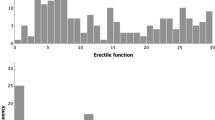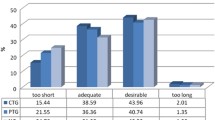Abstract
This study compared the effectiveness of two components, a ban on sexual intercourse and communication of sexual preferences, in the treatment of couples in which the male was experiencing erectile dysfunction. Sixteen couples were randomly assigned to one of two treatment conditions. In one condition spouses were asked to refrain from intercourse and to make an effort to communicate sexual tastes and preferences during noncoital erotic interaction. Couples in the second condition were assigned only the communication portion of the therapeutic instructions given to the first group. The treatment consisted of written instructions concerning tasks to be carried out at home. Therapist contact was minimal. Following a 1-month baseline period of self-monitoring using a daily record-keeping form, couples underwent a 1-month treatment period and follow-up testing after another month. Male subjects also underwent an endocrinological examination to ascertain testosterone and related hormone levels prior to participating in the treatment. Both treatment groups reported significant improvement in several measures of erectile functioning, general sexual functioning, and marital adjustment. However, the ban on intercourse did not add to the effectiveness of encouraging sexual communication, indicating that the former component probably did not contribute to change. Two pretreatment measures, the Sexual Interaction Inventory and testosterone level, were found to predict treatment outcome with sufficient accuracy to permit selection of future patients who might benefit from this type of treatment format. The effectiveness of a treatment consisting of written instructions with minimal therapist contact for males with erectile dysfunction have important cost-benefit implications.
Similar content being viewed by others
References
Hathaway, S. R., and McKinley, J. C. (1967).Minnesota Multiphasic Personality Inventory, Form R. The Psychological Corporation, New York.
Kaplan, H. S. (1974).The New Sex Therapy. Brunner/Mazel, New York.
Kilmann, P. R., and Auerbach, R. (1979). Treatments of premature ejaculation and psychogenic impotence: A critical review of the literature.Arch. Sex. Behav. 8: 81–100.
Klecka, W. R. (1970). Discriminant analysis. In Nie, N. H., Hull, C. H., Jenkins, J. G., Steinbrenner, K., and Bent, D. H. (eds.),SPSS: Statistical Package for the Social Sciences (2nd ed.), McGraw-Hill, New York, pp. 434–467.
Lobitz, W. C., and Baker, E. L., Jr. (1979). Group treatment of sexual dysfunction: Coping skill training for single males. In Upper, D., and Ross, S. M. (eds.),Behavioral Group Therapy, 1979: An Annual Review Research Press Co., Champaign, Illinois, pp. 99–115.
Locke, H. J., and Wallace, K. M. (1959). Short marital adjustment and prediction tests: Their reliability and validity.Marriage and Family Living 21: 251–255.
LoPiccolo, J. (1978). Direct treatment of sexual dysfunction. In LoPiccolo, J., and LoPiccolo, L. (eds.),Handbook of Sex Therapy Plenum Press, New York, pp. 1–18.
LoPiccolo, J., and LoPiccolo, L. (1978).Handbook of Sex Therapy. Plenum Press, New York.
LoPiccolo, J., and Steger, J. (1974). The sexual interaction inventory: A new instrument for assessment of sexual dysfunction.Arch. Sex. Behav. 3: 585–595.
Masters, W. H., and Johnson, V. E. (1970).Human Sexual Inadequacy. Little, Brown, Boston.
Nowinski, J. K., and LoPiccolo, J. (1979). Assessing sexual behavior in couples.J. Sex Marital Ther. 5: 225–243.
Pirke, K. M., Kochotte, G., Aldenhoff, J., Besinger, U., and Feil, W. (1979). Pituitary gonadal system function in patients with erectile impotence and premature ejaculation.Arch. Sex. Behav. 8: 41–48.
Price, S. C., Reynolds, B. S., Cohen, B. D., Anderson, A. J., and Schochet, B. U. (1981). Group treatment of erectile dysfunction for men without partners: A controlled evaluation.Arch. Sex. Behav. 10: 253–268.
Reynolds, B. S. (1977). Psychological treatment models and outcome results for erectile dysfunction: A critical review.Psychol. Bull. 84: 1218–1238.
Reynolds, B. S. (1978).Erectile Difficulty Questionnaire. Unpublished manuscript, Human Sexuality Program, UCLA.
Reynolds, B. S. (1980). Erectile dysfunction: A review of behavioral treatment approaches. In Deitzman, R. (ed.),Clinical Behavior Therapy and Behavior Modification (Vol. 2), Garland STPM Press, New York, pp. 121–166.
Schumacher, S., and Lloyd, C. W. (1981). Physiological and psychological factors in impotence.J. Sex Res. 17: 40–53.
Schwartz, M. F., Kolodny, R. C., and Masters, W. H. (1980). Plasma testosterone levels of sexually functional and dysfunctional men.Arch. Sex. Behav. 9: 355–366.
Spark, R. F., White, R. A., and Connolly, P. B. (1980). Impotence is not always psychogenic. Newer insights into hypothalamic-pituitary-gonadal dysfunction.J. Amer. Med. Ass. 232: 750–755.
Tukey, J. W. (1949). comparing individual means in the analysis of variance.Biometrics 5: 99–114.
Wagner, G., and Green, R. (1982).Impotence. Plenum Press, New York.
Zilbergeld, B. (1978).Male Sexuality: A Guide to Sexual Fulfillment. Little, Brown, Boston.
Author information
Authors and Affiliations
Additional information
This work was funded by Conseil Quebecois de la Recherche Sociale, Ministere des Affaires Sociales (RS 419 A80-1).
Rights and permissions
About this article
Cite this article
Takefman, J., Brender, W. An analysis of the effectiveness of two components in the treatment of erectile dysfunction. Arch Sex Behav 13, 321–340 (1984). https://doi.org/10.1007/BF01541905
Issue Date:
DOI: https://doi.org/10.1007/BF01541905




